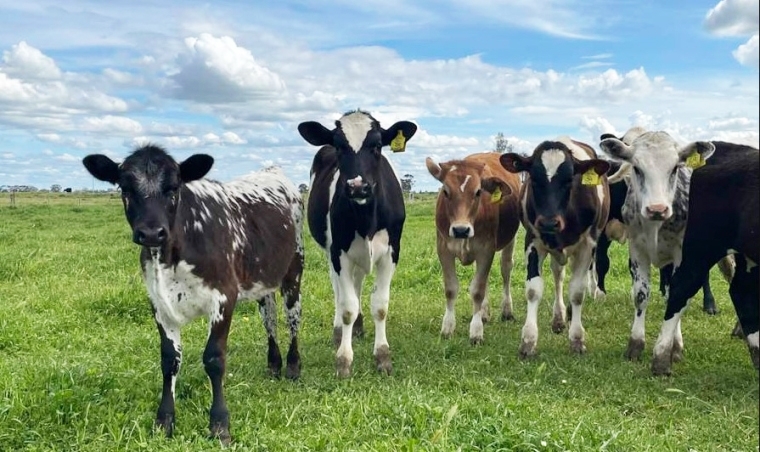
Content supplied by Rabobank.

By Emma Higgins & Jen Corkran
With nearly two million underutilised dairy calves born annually and the outlook for beef pricing strong, the opportunity for New Zealand’s agri sector to build a scalable, profitable dairy-beef system is now, according to a new report by agribusiness banking specialist Rabobank.
But there is no fast, easy solution for making productive use of these underutilised dairyborn calves, the report says, and realising this ‘dairy-beef’ opportunity – which has a potential value in excess of $1.2 billion annually – will require coordinated action across breeding, rearing and value chain relationships.
In the report The strategic moment for dairy-beef in New Zealand, RaboResearch says the dairy-beef opportunity represents a strategic crossroads for New Zealand’s agricultural sector.
“Global beef demand is rising – and New Zealand must act,” report co-author RaboResearch senior animal protein analyst Jen Corkran said.
“Strong export prices and tightening global supply create a lucrative window for New Zealand to expand its beef footprint, and herd rebuilding takes time and requires coordinated, cross-sector action.”
Ms Corkran said inaction may also risk New Zealand’s social licence and market access.
“Reducing early calf slaughter is not just an economic imperative – it’s a reputational one. A more integrated dairy-beef system may help protect New Zealand’s global brand and future-proof its livestock sector,” she said.
“For New Zealand to succeed in developing a well-functioning dairy-beef system, collaboration is non-negotiable. A connected value chain – from breeders to finishers – is essential to unlock consistent supply, improve margins and meet evolving consumer and market expectations for ethical, sustainable beef.”
Scale of opportunity
The report says that each year, New Zealand’s dairy farms produce around four million calves with approximately 28% retained as replacement dairy heifers.
“The remaining 70+ % are surplus to dairy requirements, and just over one quarter of calves born to dairy farmers are currently reared as dairy-beef,” Ms Corkran said.
“The additional calves are often sent for processing at four to five days old and herein lies the opportunity to create more value from the almost two million “other” calves (referred to locally as ‘bobby calves’) that are currently underutilised.”
Beyond risk mitigation linked to the negative public perceptions associated with bobby calf slaughter, Ms Corkran said, the scale of the commercial opportunity for New Zealand’s dairy-beef sector warrants serious attention.
“At current average market prices for the 2024/25 export season, rearing an additional 600,000 surplus calves could unlock well over $1.2 billion in value,” she said.
Calving conundrum and other challenges
The report says the bulk of New Zealand’s dairy herd has an early-spring calving pattern, which aims to match the herd’s feed demand with peak pasture growth.
“Subsequently, the majority of dairy calves are born usually within a six-week period prior to October,” Ms Corkran said.
“This seasonal, pasture-based dairy system – while efficient for milk production – creates a concentrated calving window that can limit the capacity to rear all dairy calves born. And this structural constraint is one of the key components in New Zealand’s dairy-beef challenge.
“If New Zealand wants consistent beef supply and long-term value, it may need to invest more in calves. The industry also needs to rethink economic models and incentives for calf rearing to avoid future boom-bust rearing cycles.
“Completely eliminating bobby calves may not be practical or achievable in the short term, but significantly reducing numbers is a realistic and worthwhile goal.
“Our base assumption is that New Zealand can reduce bobby calf numbers and better utilise those retained within the beef supply chain – while also improving the quality of dairybeef calves already being reared.”
New Zealand dairy-beef reimagined
To overcome these challenges and unlock system-wide value, Ms Corkran said, a coordinated strategy across genetics, data, risk-sharing and market alignment was required.
“RaboResearch sees potential value in exploring the concept of a national dairy-beef breeding strategy,” Ms Corkran said.
“This idea would benefit from a pan-sector approach, supported by robust data and aligned with economic, genetic, and environmental objectives. With broader industry engagement and the right support, including potential funding through MPI’s Primary Sector Growth Fund, this concept could help unlock significant progress across the sector.”
Ms Corkran said the breeding decisions made by dairy farmers at the start of the dairy-beef value chain have a direct impact on the quality and profitability of dairy-beef animals further down the line.
“A more strategic approach to breeding, in terms of both the genetics used and the timing of reproduction, can unlock significant value, without necessarily needing to overhaul the entire dairy herd,” she said.
“With strategic use of artificial insemination (AI) for improved beef genetics, in addition to wearable technology and breed selection tools, dairy farmers can continue to target essential dairy traits like short gestation and calving ease – along with growth efficiency.
“We’re also supportive of further investigation into calf ‘passports’ and data integration. A traceability system linking genetic characteristics to each calf’s permanent record – similar to Ireland’s model – would improve transparency, reward investment in superior genetics and support marketability. And this could be tied to contract pricing and track calves through multiple ownership changes.”
Ms Corkran said risk reallocation across the value chain is also likely to be an important driver in the creation of a profitable dairy-beef system.
“Rearers often carry disproportionate risk. Models such as performance-based management fees or fixed-price contracts from insemination, with premiums tied to growth, could provide financial certainty and incentivise quality breeding and rearing,” she said.
“In addition, processor involvement and value-chain ownership will be essential. Dairy and meat processors must lead in building an end-to-end dairy-beef strategy. Continued development of dairy-beef programmes must be informed by market feedback. A rapid feedback loop between genetics providers and end users would help ensure breeding decisions remain commercially viable.”
Pāmu – a case study
The report says the strategy being utilised by government-owned farming enterprise Pāmu may offer a blueprint for integrating dairy and beef systems across the country at scale.
“Pāmu first began their dairy-beef journey in 2016 and it has gained significant momentum in recent years with the dairy business going from rearing only their replacement heifer calves to now rearing 69% of all calves born in the 2025 fiscal year,” Ms Corkran said.
“Pāmu plans to rear 10,500 calves annually by 2026–2027, with full implementation targeted across all 42 dairy farms – milking 40,000 cows – and rearing 100% of calves by the end of the decade.
“The approach requires significant investment, careful planning and long-term commitment. Still, it proves that with the right tools dairy-beef systems are possible in pastoral NZ.”
Dairy-beef gaining global traction
RaboResearch senior analyst Emma Higgins said the dairy-beef opportunity was not limited to New Zealand, with dairy-beef also gaining global traction.
“In addition to our New Zealand-focused report, RaboResearch has released a global report exploring dairy-beef opportunities in other countries around the globe including in the US, Ireland and Australia,” she said. T
he global report Beefing up global dairy with dairy-beef says market signals are a key driver of dairy-beef momentum, but their strength varies by region.
“The US leads with fast feedback loops, Ireland with policy support, while New Zealand and Australia face slower signals due to less domestic demand and export market complexity,” Ms Higgins said.
“The opportunity is clear – but execution is the likely challenge. New Zealand and Australia must align breeding strategies with market demand, invest in infrastructure and build integrated supply chains to realise the full value of dairy-beef.”
Ms Higgins said Ireland’s dairy-beef scene had expanded significantly over recent years and, alongside Pāmu, acted as a further useful case study for New Zealand’s wider agri sector.
“Ireland’s dairy-beef sector has grown strongly, driven by the growth of the national dairy herd and a deliberate, well-funded strategy to integrate beef production into dairy systems,” she said.
“Since 2022, Ireland has seen a sharp rise in beef-sired calves within dairy herds, while the number of dairy-sired calves has declined. This reflects a strategic shift in breeding, driven by stronger dairy profitability and the opportunity to capitalise on firm beef prices over the next two to three years.”
Ms Higgins said policy support is underpinning the transition.
“Ireland’s dairy-beef strategy is backed by a suite of incentive programmes, including the Dairy-beef Welfare Scheme, which gives farmers €20 per eligible calf (up to 50 calves/year) and is co-financed by the EU and the National Genotyping Programme, which aims to genotype the entire national herd, improving genetic gain and traceability,” she said.
“Looking ahead, the Irish Cattle Breeding Federation (ICBF) projects that by 2032, Ireland will rear about 900,000 dairy-beef calves annually. And this, combined with a fully genotyped herd in development, demonstrates Ireland is emerging as a global leader in strategic, policy-driven dairy-beef integration.”

We welcome your comments below. If you are not already registered, please register to comment.
Remember we welcome robust, respectful and insightful debate. We don't welcome abusive or defamatory comments and will de-register those repeatedly making such comments. Our current comment policy is here.